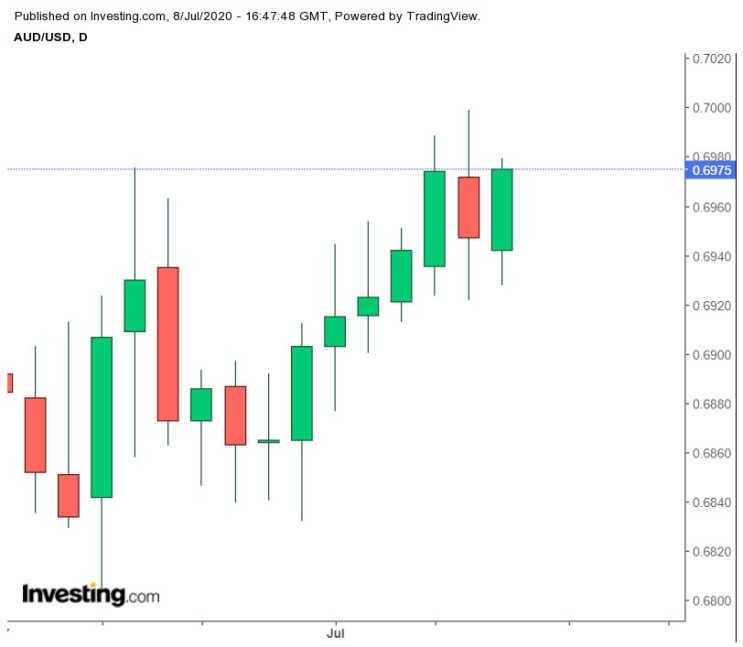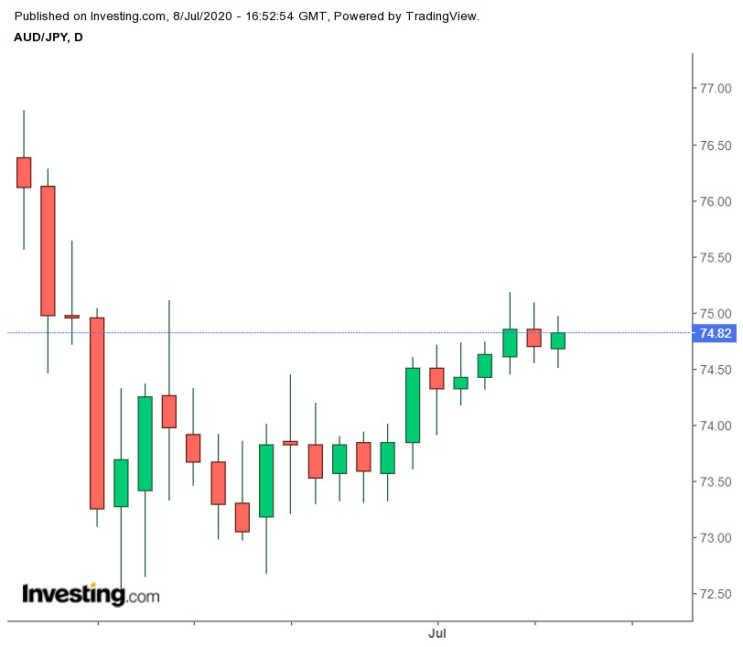The AUD/USD currency pair has been trading between 0.68 levels and 0.70 levels from mid-June. 0.6675 is a crucial level where the 200 EMA lies.

Victoria premier Daniel Andrews has announced a level 3 restriction in Melbourne and Mitchell Shire for six weeks. New restrictions have been announced as it enters into the community transmission stage of COVID-19. This will confine 4.9 million in Australia’s second-biggest city in their homes.
AUD/USD Exchange Rate Forecast
On Wednesday, 8 July, the AUD/USD pair was seen ranging between 0.6974 and 0.6927 at GMT 2:52 p.m.
AUD/USD almost touched 0.70 on Tuesday, 7 July, but reversed after reaching a high of 0.6998. This area continues to see an increase in the selling pressure on the Australian dollar. It requires strong bulls to push the pair past this stiff resistance zone. If it breaks past this top, it may touch June’s high of 0.7063.
In the short-term, if the Australian Dollar moves past 0.6947 levels, it will rise towards 0.6989 and 0.6999. Further, 0.6950 level is where the 38.2 Fibonacci levels lie and this is an area to watch out for. Support levels continue to be at 0.6928 and 0.6910.
But it can be said that the AUD/USD currency pair is moving in a sideway-trading range between 0.6800 and 0.7010.
Risk sentiment is high as the rising coronavirus cases are seen to increase. Experts say that with stimulus measures exhausting, the economic growth may face a downturn. Businesses face uncertainty as spending decreases. Consumption and investment will determine the future of the economy and the currency will move accordingly.
Australian Prime Minister Scott Morrison fears that the economy will need financial support for the second lockdown.
The Australian dollar has ended positively for the past three weeks but is pausing now with a sideways move. As long as the AUD/USD continues to hold levels of 0.6900, it will remain within a bullish zone.
The Reserve Bank of Australia has not changed interest rates which are currently at 0.25%. The RBA observes that the economic situation is much better than feared. RBA governor Philip Lowe states that leading indicators have picked up in the economy recently. However, the outlook remains uncertain, he says.
Interest rates remain at record low levels of 0.25%. The 3-year yield target is 0.25% percent too. The bank has promised more support for the economy to ensure that Australia can move towards recovery.
Experts say that retail spending has improved and the downturn is not as severe as it was feared. However, with the outbreak in Melbourne, sales have plunged in restaurants in Victoria. Subsequently, it is also affecting neighbouring regions like Queensland and New South Wales too.
Policymakers have not mentioned anything about a double-digit recovery from the March lows. No mention was made about geopolitical tensions either, claim economists.
RBA Comes Under Pressure to Jumpstart the Economy
The AUD/JPY pair retreated from a high of 74.82 on Wednesday and closed flat for the day. The Japanese currency is not showing much strength.
Economic Minister Yasutohshi Nishimura has reported that bank deposits in the Bank of Japan have increased by 6.2 percent in June. There has also been a hike in Certificate of Deposits. He says that investors are resorting to investment in safe-haven currencies as fear increases in the economy.
The yen saw strong resistance at 75.18 on 6 July. It continues to face stiff resistance at this level and needs fresh bull pressure to cross this level. Meanwhile, it faces strong support at 73.30 levels. Another level to watch out for is the 21-day SMA which is at 74.00.
Australian Treasurer Josh Frydenberg has hinted at an income support extension scheme. The JobKeeper Payment is set to expire on Sep 27 and the RBA may come under pressure to support the economy. The Forward Guidance by the Reserve Bank of Australia will set the trend on the currency pair AUD/JPY.
The six-week lockdown in Melbourne is raising concern, along with rising Covid-19 cases in Tokyo and the US.
Sticking Points Continue to Hamper Trade Talks Between UK and EU
Meanwhile, the Pound continues to gain strength against the dollar on Tuesday. A post-Brexit talk between the UK and EU will determine the continuing strength of the Pound. If talks do not materialize positively, the Sterling may lose strength, say analysts. The clock is ticking and time is running out for the two economies to strike a deal. There are key sticking points that continue to hamper talks.
In the Eurozone, geopolitical uncertainty continues to hinder growth prospects. Brussels has warned that the economy will shrink one-point further from the prior forecast at 8.7 percent for 2020. The reports have affected the currency markets too. Germany factory orders report a 19.3 contraction, worse than estimated -16.9 percent.
Safe-haven Dollar attracts investors every time the pandemic resurges and the global economy comes under threat.

